Business Law Assignment on Negligent Misrepresentation and Contracts
VerifiedAdded on 2021/04/17
|6
|1417
|114
Homework Assignment
AI Summary
This business law assignment solution addresses several legal issues through a series of tasks. Task 1 examines negligent misrepresentation, where Emma, a store manager, is accused of providing incorrect information to Richard, leading to monetary damages. Task 2 explores promissory estoppel, focusing on whether George can demand additional rent from Richard after initially promising not to. Task 3 analyzes a counteroffer scenario, determining if Richard can compel Tom to purchase his car at the original offer price after making a counteroffer. Finally, Task 4 investigates the validity of a contract based on past consideration, determining if Martin can sue Richard for not providing a car after past services. Each task includes an issue statement, relevant laws, application of the law to the facts, and a conclusion, supported by case law and legal principles.
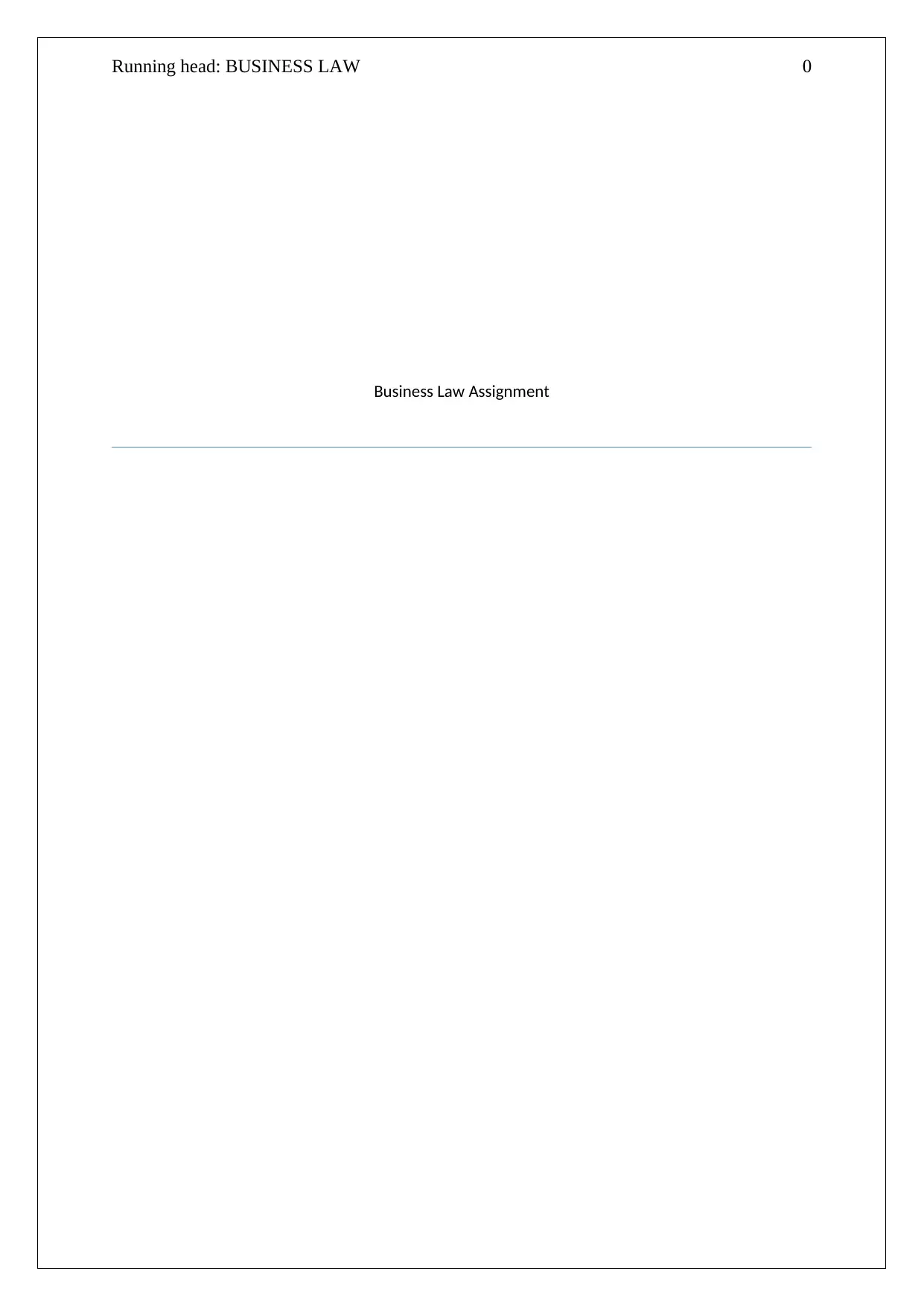
Running head: BUSINESS LAW 0
Business Law Assignment
Business Law Assignment
Paraphrase This Document
Need a fresh take? Get an instant paraphrase of this document with our AI Paraphraser
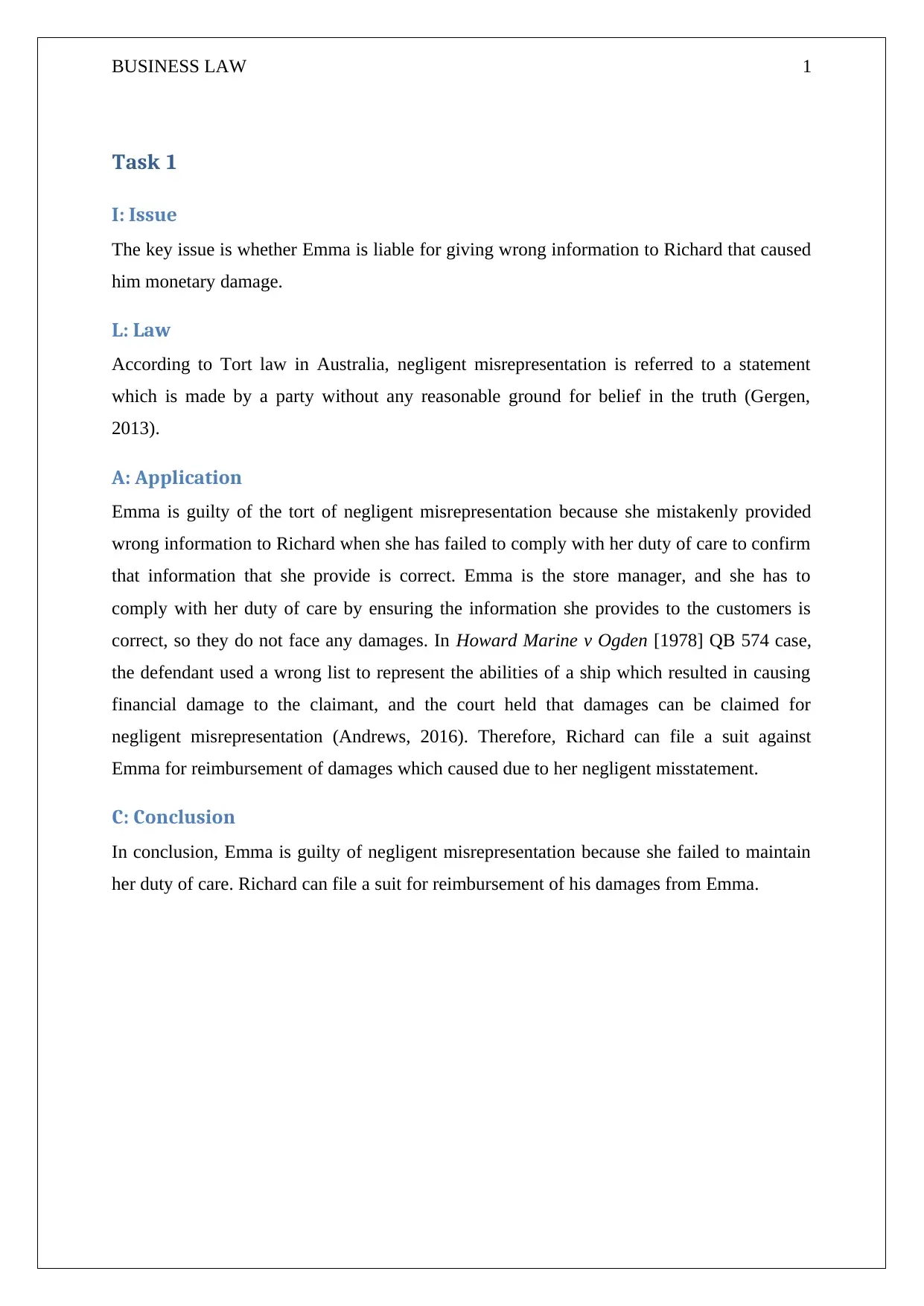
BUSINESS LAW 1
Task 1
I: Issue
The key issue is whether Emma is liable for giving wrong information to Richard that caused
him monetary damage.
L: Law
According to Tort law in Australia, negligent misrepresentation is referred to a statement
which is made by a party without any reasonable ground for belief in the truth (Gergen,
2013).
A: Application
Emma is guilty of the tort of negligent misrepresentation because she mistakenly provided
wrong information to Richard when she has failed to comply with her duty of care to confirm
that information that she provide is correct. Emma is the store manager, and she has to
comply with her duty of care by ensuring the information she provides to the customers is
correct, so they do not face any damages. In Howard Marine v Ogden [1978] QB 574 case,
the defendant used a wrong list to represent the abilities of a ship which resulted in causing
financial damage to the claimant, and the court held that damages can be claimed for
negligent misrepresentation (Andrews, 2016). Therefore, Richard can file a suit against
Emma for reimbursement of damages which caused due to her negligent misstatement.
C: Conclusion
In conclusion, Emma is guilty of negligent misrepresentation because she failed to maintain
her duty of care. Richard can file a suit for reimbursement of his damages from Emma.
Task 1
I: Issue
The key issue is whether Emma is liable for giving wrong information to Richard that caused
him monetary damage.
L: Law
According to Tort law in Australia, negligent misrepresentation is referred to a statement
which is made by a party without any reasonable ground for belief in the truth (Gergen,
2013).
A: Application
Emma is guilty of the tort of negligent misrepresentation because she mistakenly provided
wrong information to Richard when she has failed to comply with her duty of care to confirm
that information that she provide is correct. Emma is the store manager, and she has to
comply with her duty of care by ensuring the information she provides to the customers is
correct, so they do not face any damages. In Howard Marine v Ogden [1978] QB 574 case,
the defendant used a wrong list to represent the abilities of a ship which resulted in causing
financial damage to the claimant, and the court held that damages can be claimed for
negligent misrepresentation (Andrews, 2016). Therefore, Richard can file a suit against
Emma for reimbursement of damages which caused due to her negligent misstatement.
C: Conclusion
In conclusion, Emma is guilty of negligent misrepresentation because she failed to maintain
her duty of care. Richard can file a suit for reimbursement of his damages from Emma.
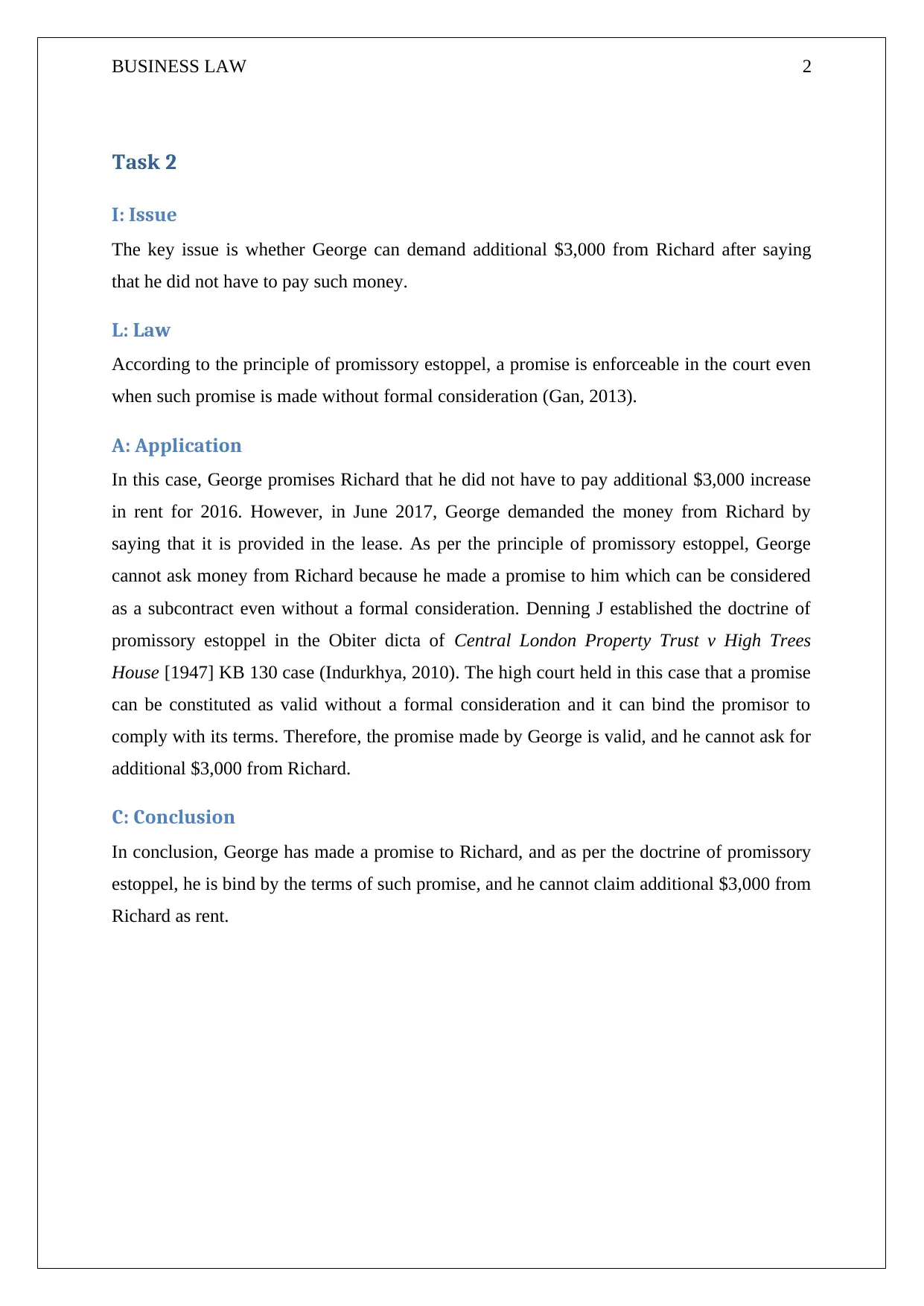
BUSINESS LAW 2
Task 2
I: Issue
The key issue is whether George can demand additional $3,000 from Richard after saying
that he did not have to pay such money.
L: Law
According to the principle of promissory estoppel, a promise is enforceable in the court even
when such promise is made without formal consideration (Gan, 2013).
A: Application
In this case, George promises Richard that he did not have to pay additional $3,000 increase
in rent for 2016. However, in June 2017, George demanded the money from Richard by
saying that it is provided in the lease. As per the principle of promissory estoppel, George
cannot ask money from Richard because he made a promise to him which can be considered
as a subcontract even without a formal consideration. Denning J established the doctrine of
promissory estoppel in the Obiter dicta of Central London Property Trust v High Trees
House [1947] KB 130 case (Indurkhya, 2010). The high court held in this case that a promise
can be constituted as valid without a formal consideration and it can bind the promisor to
comply with its terms. Therefore, the promise made by George is valid, and he cannot ask for
additional $3,000 from Richard.
C: Conclusion
In conclusion, George has made a promise to Richard, and as per the doctrine of promissory
estoppel, he is bind by the terms of such promise, and he cannot claim additional $3,000 from
Richard as rent.
Task 2
I: Issue
The key issue is whether George can demand additional $3,000 from Richard after saying
that he did not have to pay such money.
L: Law
According to the principle of promissory estoppel, a promise is enforceable in the court even
when such promise is made without formal consideration (Gan, 2013).
A: Application
In this case, George promises Richard that he did not have to pay additional $3,000 increase
in rent for 2016. However, in June 2017, George demanded the money from Richard by
saying that it is provided in the lease. As per the principle of promissory estoppel, George
cannot ask money from Richard because he made a promise to him which can be considered
as a subcontract even without a formal consideration. Denning J established the doctrine of
promissory estoppel in the Obiter dicta of Central London Property Trust v High Trees
House [1947] KB 130 case (Indurkhya, 2010). The high court held in this case that a promise
can be constituted as valid without a formal consideration and it can bind the promisor to
comply with its terms. Therefore, the promise made by George is valid, and he cannot ask for
additional $3,000 from Richard.
C: Conclusion
In conclusion, George has made a promise to Richard, and as per the doctrine of promissory
estoppel, he is bind by the terms of such promise, and he cannot claim additional $3,000 from
Richard as rent.
⊘ This is a preview!⊘
Do you want full access?
Subscribe today to unlock all pages.

Trusted by 1+ million students worldwide
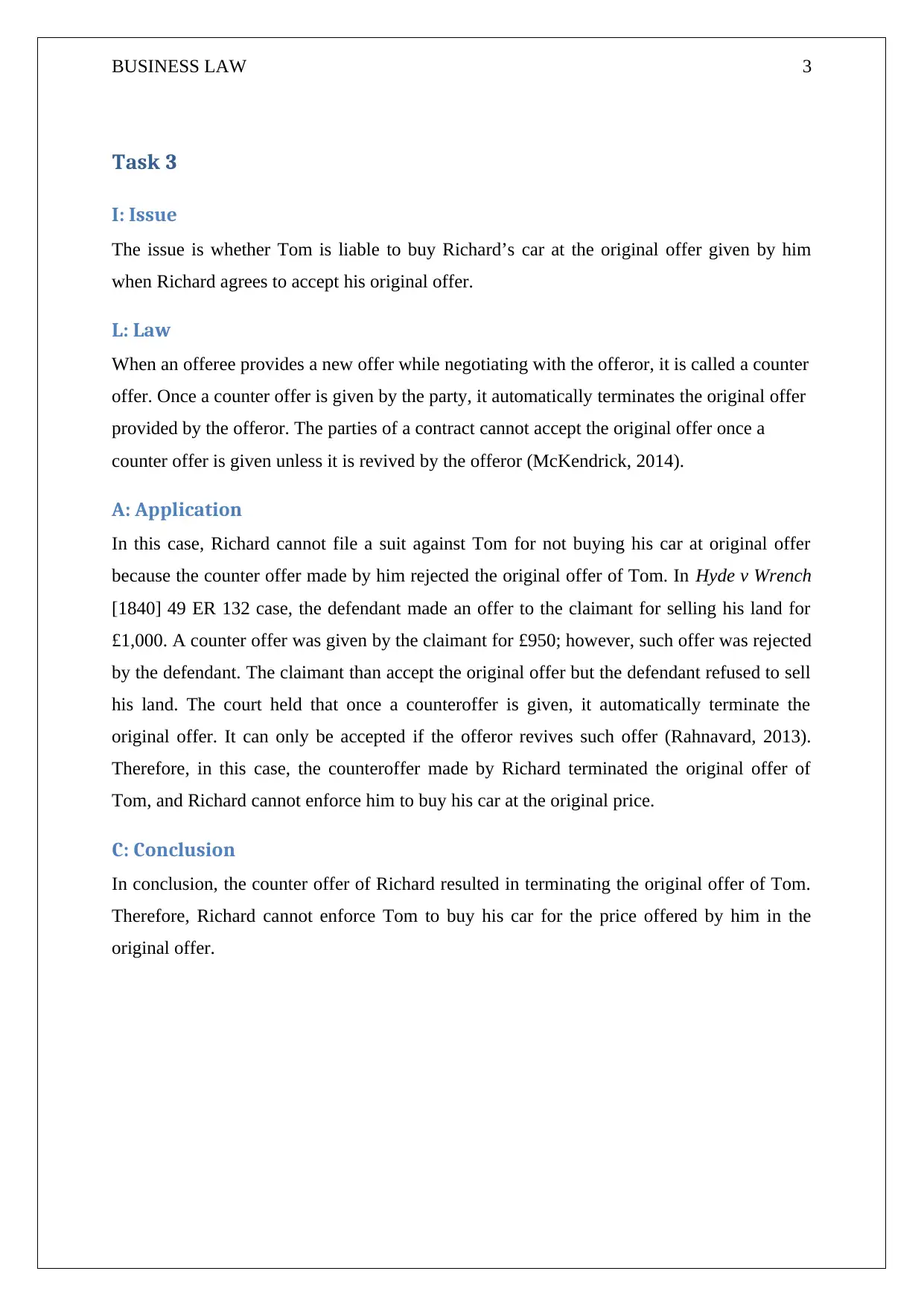
BUSINESS LAW 3
Task 3
I: Issue
The issue is whether Tom is liable to buy Richard’s car at the original offer given by him
when Richard agrees to accept his original offer.
L: Law
When an offeree provides a new offer while negotiating with the offeror, it is called a counter
offer. Once a counter offer is given by the party, it automatically terminates the original offer
provided by the offeror. The parties of a contract cannot accept the original offer once a
counter offer is given unless it is revived by the offeror (McKendrick, 2014).
A: Application
In this case, Richard cannot file a suit against Tom for not buying his car at original offer
because the counter offer made by him rejected the original offer of Tom. In Hyde v Wrench
[1840] 49 ER 132 case, the defendant made an offer to the claimant for selling his land for
£1,000. A counter offer was given by the claimant for £950; however, such offer was rejected
by the defendant. The claimant than accept the original offer but the defendant refused to sell
his land. The court held that once a counteroffer is given, it automatically terminate the
original offer. It can only be accepted if the offeror revives such offer (Rahnavard, 2013).
Therefore, in this case, the counteroffer made by Richard terminated the original offer of
Tom, and Richard cannot enforce him to buy his car at the original price.
C: Conclusion
In conclusion, the counter offer of Richard resulted in terminating the original offer of Tom.
Therefore, Richard cannot enforce Tom to buy his car for the price offered by him in the
original offer.
Task 3
I: Issue
The issue is whether Tom is liable to buy Richard’s car at the original offer given by him
when Richard agrees to accept his original offer.
L: Law
When an offeree provides a new offer while negotiating with the offeror, it is called a counter
offer. Once a counter offer is given by the party, it automatically terminates the original offer
provided by the offeror. The parties of a contract cannot accept the original offer once a
counter offer is given unless it is revived by the offeror (McKendrick, 2014).
A: Application
In this case, Richard cannot file a suit against Tom for not buying his car at original offer
because the counter offer made by him rejected the original offer of Tom. In Hyde v Wrench
[1840] 49 ER 132 case, the defendant made an offer to the claimant for selling his land for
£1,000. A counter offer was given by the claimant for £950; however, such offer was rejected
by the defendant. The claimant than accept the original offer but the defendant refused to sell
his land. The court held that once a counteroffer is given, it automatically terminate the
original offer. It can only be accepted if the offeror revives such offer (Rahnavard, 2013).
Therefore, in this case, the counteroffer made by Richard terminated the original offer of
Tom, and Richard cannot enforce him to buy his car at the original price.
C: Conclusion
In conclusion, the counter offer of Richard resulted in terminating the original offer of Tom.
Therefore, Richard cannot enforce Tom to buy his car for the price offered by him in the
original offer.
Paraphrase This Document
Need a fresh take? Get an instant paraphrase of this document with our AI Paraphraser
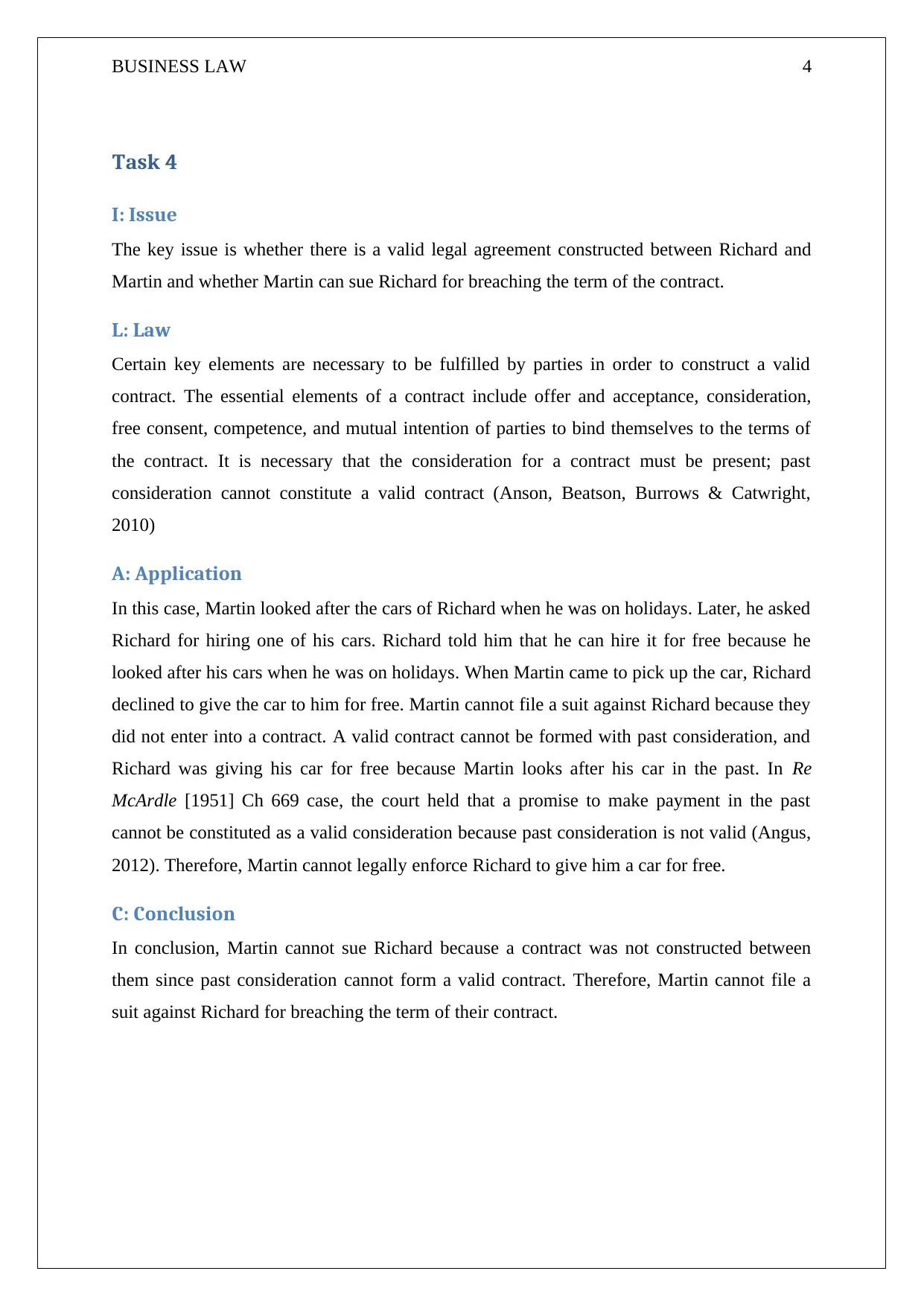
BUSINESS LAW 4
Task 4
I: Issue
The key issue is whether there is a valid legal agreement constructed between Richard and
Martin and whether Martin can sue Richard for breaching the term of the contract.
L: Law
Certain key elements are necessary to be fulfilled by parties in order to construct a valid
contract. The essential elements of a contract include offer and acceptance, consideration,
free consent, competence, and mutual intention of parties to bind themselves to the terms of
the contract. It is necessary that the consideration for a contract must be present; past
consideration cannot constitute a valid contract (Anson, Beatson, Burrows & Catwright,
2010)
A: Application
In this case, Martin looked after the cars of Richard when he was on holidays. Later, he asked
Richard for hiring one of his cars. Richard told him that he can hire it for free because he
looked after his cars when he was on holidays. When Martin came to pick up the car, Richard
declined to give the car to him for free. Martin cannot file a suit against Richard because they
did not enter into a contract. A valid contract cannot be formed with past consideration, and
Richard was giving his car for free because Martin looks after his car in the past. In Re
McArdle [1951] Ch 669 case, the court held that a promise to make payment in the past
cannot be constituted as a valid consideration because past consideration is not valid (Angus,
2012). Therefore, Martin cannot legally enforce Richard to give him a car for free.
C: Conclusion
In conclusion, Martin cannot sue Richard because a contract was not constructed between
them since past consideration cannot form a valid contract. Therefore, Martin cannot file a
suit against Richard for breaching the term of their contract.
Task 4
I: Issue
The key issue is whether there is a valid legal agreement constructed between Richard and
Martin and whether Martin can sue Richard for breaching the term of the contract.
L: Law
Certain key elements are necessary to be fulfilled by parties in order to construct a valid
contract. The essential elements of a contract include offer and acceptance, consideration,
free consent, competence, and mutual intention of parties to bind themselves to the terms of
the contract. It is necessary that the consideration for a contract must be present; past
consideration cannot constitute a valid contract (Anson, Beatson, Burrows & Catwright,
2010)
A: Application
In this case, Martin looked after the cars of Richard when he was on holidays. Later, he asked
Richard for hiring one of his cars. Richard told him that he can hire it for free because he
looked after his cars when he was on holidays. When Martin came to pick up the car, Richard
declined to give the car to him for free. Martin cannot file a suit against Richard because they
did not enter into a contract. A valid contract cannot be formed with past consideration, and
Richard was giving his car for free because Martin looks after his car in the past. In Re
McArdle [1951] Ch 669 case, the court held that a promise to make payment in the past
cannot be constituted as a valid consideration because past consideration is not valid (Angus,
2012). Therefore, Martin cannot legally enforce Richard to give him a car for free.
C: Conclusion
In conclusion, Martin cannot sue Richard because a contract was not constructed between
them since past consideration cannot form a valid contract. Therefore, Martin cannot file a
suit against Richard for breaching the term of their contract.
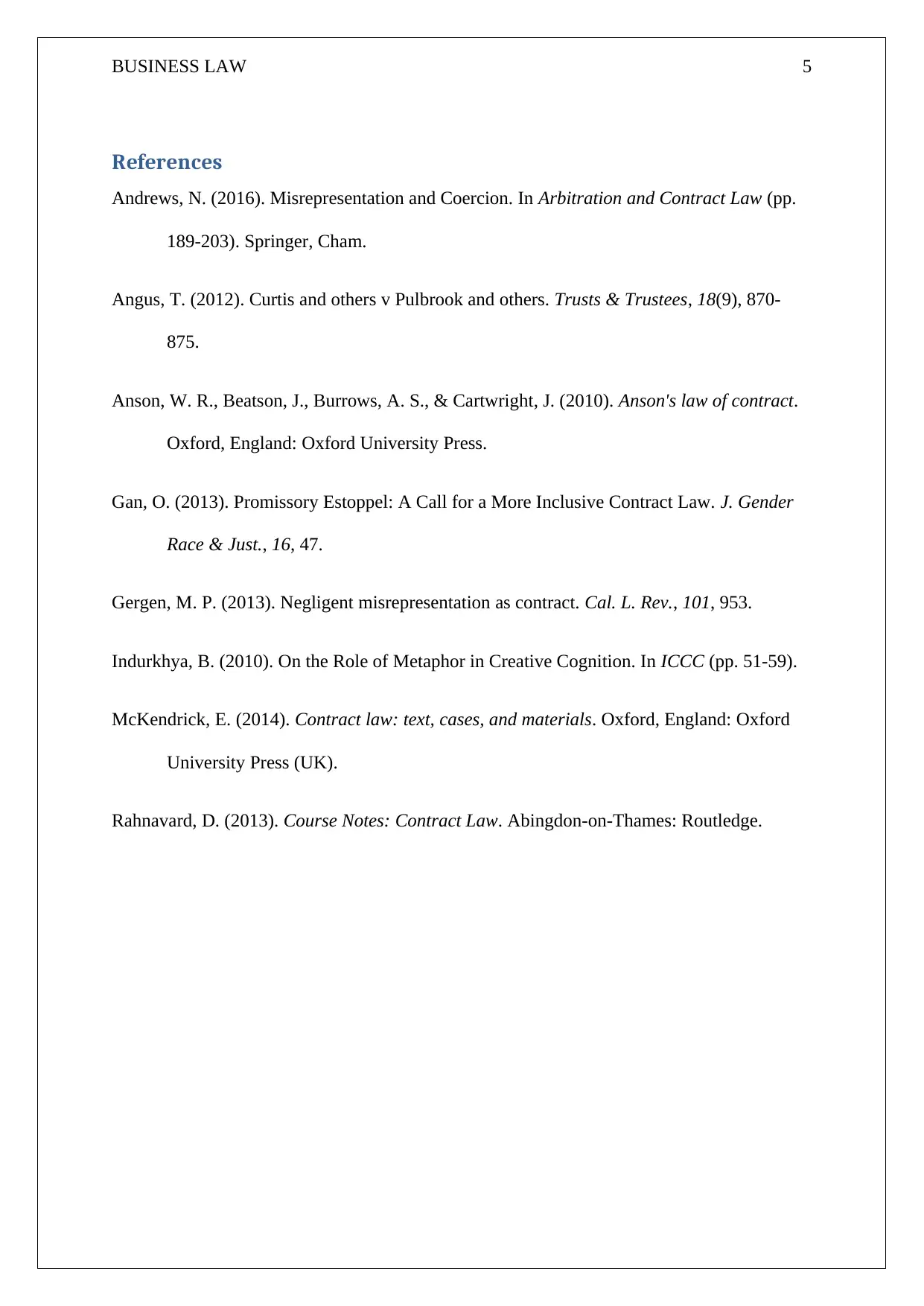
BUSINESS LAW 5
References
Andrews, N. (2016). Misrepresentation and Coercion. In Arbitration and Contract Law (pp.
189-203). Springer, Cham.
Angus, T. (2012). Curtis and others v Pulbrook and others. Trusts & Trustees, 18(9), 870-
875.
Anson, W. R., Beatson, J., Burrows, A. S., & Cartwright, J. (2010). Anson's law of contract.
Oxford, England: Oxford University Press.
Gan, O. (2013). Promissory Estoppel: A Call for a More Inclusive Contract Law. J. Gender
Race & Just., 16, 47.
Gergen, M. P. (2013). Negligent misrepresentation as contract. Cal. L. Rev., 101, 953.
Indurkhya, B. (2010). On the Role of Metaphor in Creative Cognition. In ICCC (pp. 51-59).
McKendrick, E. (2014). Contract law: text, cases, and materials. Oxford, England: Oxford
University Press (UK).
Rahnavard, D. (2013). Course Notes: Contract Law. Abingdon-on-Thames: Routledge.
References
Andrews, N. (2016). Misrepresentation and Coercion. In Arbitration and Contract Law (pp.
189-203). Springer, Cham.
Angus, T. (2012). Curtis and others v Pulbrook and others. Trusts & Trustees, 18(9), 870-
875.
Anson, W. R., Beatson, J., Burrows, A. S., & Cartwright, J. (2010). Anson's law of contract.
Oxford, England: Oxford University Press.
Gan, O. (2013). Promissory Estoppel: A Call for a More Inclusive Contract Law. J. Gender
Race & Just., 16, 47.
Gergen, M. P. (2013). Negligent misrepresentation as contract. Cal. L. Rev., 101, 953.
Indurkhya, B. (2010). On the Role of Metaphor in Creative Cognition. In ICCC (pp. 51-59).
McKendrick, E. (2014). Contract law: text, cases, and materials. Oxford, England: Oxford
University Press (UK).
Rahnavard, D. (2013). Course Notes: Contract Law. Abingdon-on-Thames: Routledge.
⊘ This is a preview!⊘
Do you want full access?
Subscribe today to unlock all pages.

Trusted by 1+ million students worldwide
1 out of 6
Related Documents
Your All-in-One AI-Powered Toolkit for Academic Success.
+13062052269
info@desklib.com
Available 24*7 on WhatsApp / Email
![[object Object]](/_next/static/media/star-bottom.7253800d.svg)
Unlock your academic potential
Copyright © 2020–2025 A2Z Services. All Rights Reserved. Developed and managed by ZUCOL.





